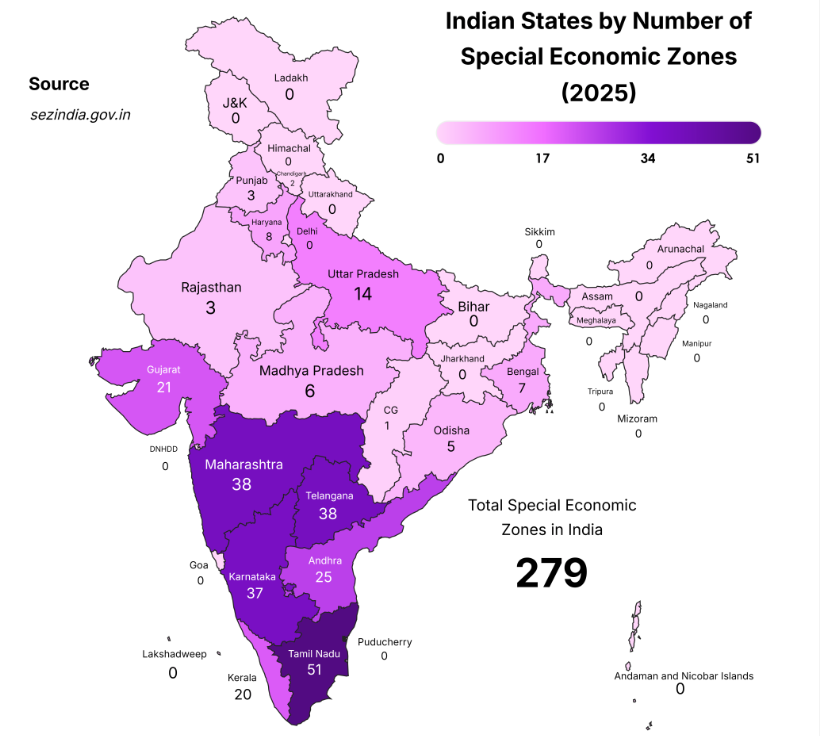



The government is revising SEZ norms to help exporters access the domestic market amid steep US tariffs. Proposed measures include allowing reverse job work, improving utilization of SEZ units, extending export obligations, and easing financial stress. Sectors like gems and jewellery, heavily reliant on SEZs, are most affected. Challenges include low R&D investment, limited skill development, negative trade balances, and low FDI. Reforms aim to boost manufacturing efficiency, safeguard jobs, and enhance global competitiveness.

Copyright infringement not intended
Picture Courtesy: Indian Express
A government panel, including officials from the Commerce Ministry, Industry Ministry, NITI Aayog, and exporter representatives, is working on new norms for Special Economic Zones (SEZs). The aim is to boost manufacturing and allow SEZ units to sell in the domestic market, amid rising US tariffs that have made exports uncompetitive.
Special Economic Zones (SEZs) are geographically demarcated areas within a country that operate under a distinct set of economic laws and regulatory frameworks, designed to attract investment, boost exports, promote industrialization, and generate employment. They provide a liberalized business environment with incentives such as tax holidays, duty-free imports, simplified customs procedures, and relaxed labour regulations.
|
Must Read: SEZ | Development of Enterprises and Service Hubs (DESH) | SEZ rules to boost Semiconductors |

Picture Courtesy: SEZ INDIA
Shift in Global Trade Dynamics: SEZs were originally designed to promote export-led growth, but changing global trade policies, tariffs, and protectionism have created challenges. For instance, recent US tariffs on certain Indian exports, especially in the gems & jewellery sector, have reduced the competitiveness of SEZ-produced goods. Many SEZ units, which primarily catered to the US market, have reported that their exports have become unviable, forcing them to request de-notification to operate in the domestic market.
Underutilization of Capacity: SEZ units often operate below capacity due to seasonal fluctuations in export demand. Equipment, labor, and production infrastructure remain underutilized for significant parts of the year. Introducing new norms, such as allowing SEZs to serve the Domestic Tariff Area (DTA) through “reverse job work,” can enhance efficiency and optimize resource use.
Low Domestic Market Integration: Currently, domestic sales from SEZs constitute only 2% of total production (FY25 data, India’s 276 SEZ units). This indicates that SEZs are heavily export-dependent. New norms can allow SEZs to participate more in the domestic market, balancing domestic demand with export focus, and reducing vulnerability to global trade shocks.
Need for Technological Upgradation and R&D: Many SEZs face low investments in research and development and skill development. For example, a survey of 14 gems & jewellery SEZ units revealed that only 4 reported any R&D investment. New norms can incentivize innovation, technology adoption, and skill enhancement, making SEZs more competitive globally.
Enhancing Competitiveness: India’s SEZs lag behind global peers like China and Vietnam, where SEZs are more diversified and technologically advanced. For instance, China’s SEZs transformed Shenzhen from a small town into a global manufacturing hub, attracting massive FDI and boosting exports. India’s SEZs need reform to improve competitiveness, attract FDI, and strengthen export performance.
Addressing Negative Trade Balance in SEZs: Some sectors, like gems & jewellery, face rising imports of raw materials, creating a negative trade balance. New SEZ norms can help balance this through better regulation of import-export flows and integration with domestic industries.
Policy Flexibility and Faster Implementation: Delays in passing the SEZ Bill and rigid regulations have hindered reforms. A new set of norms can provide faster policy implementation, address sector-specific challenges, and safeguard jobs amid global uncertainties.
Diversify Market Access
Promote Technological Upgradation and R&D
Strengthen Skill Development
Attract Strategic FDI
Policy Flexibility and Faster Approvals
Special Economic Zones (SEZs) have been vital for India’s exports, investment, and employment, but rising global tariffs and structural inefficiencies have exposed their limitations. With domestic sales at only 2% of production and low R&D and skill development, many SEZ units struggle to remain competitive.
Reforms like reverse job work, enhanced R&D, skill development, strategic FDI, and streamlined policies can make SEZs more flexible and resilient. Balancing export focus with domestic market integration and innovation will help SEZs sustain growth, protect jobs, and strengthen India’s manufacturing ecosystem in a changing global economy.
Source: The Indian Express
|
Practice Question Critically examine the need for reforms in India’s Special Economic Zones (SEZs) to enhance competitiveness, support exports, and integrate with the domestic market. Suggest measures to address existing challenges. (250 words) |
SEZs are designated areas in a country that operate under different economic regulations than the rest of the nation to attract investment, boost exports, and promote industrial growth.
New norms aim to allow SEZ units, especially those affected by US tariffs, to access the domestic market, improve efficiency, and sustain jobs amid declining export competitiveness.
It is a policy proposal allowing SEZ units to undertake work for the domestic market, making better use of labour and equipment during periods of low export demand.








© 2025 iasgyan. All right reserved